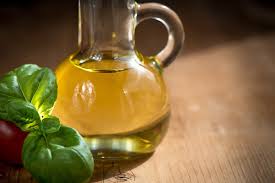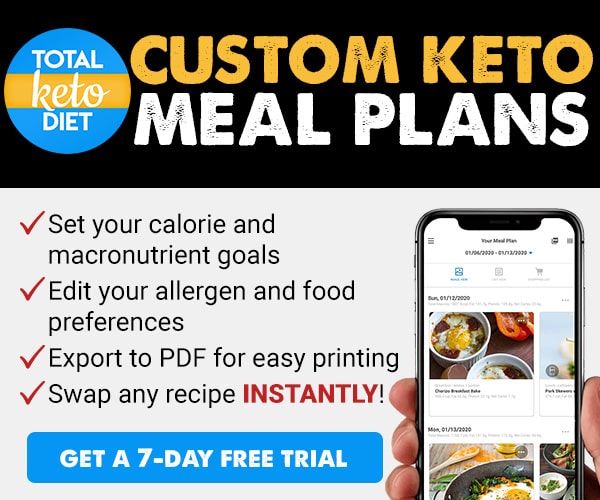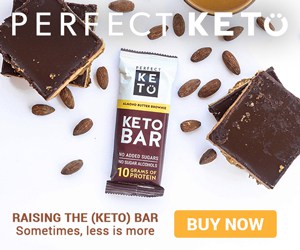The Keto Flu is one of the several hurdles anybody can possibly face on the early stages of kick starting the ketogenic diet. This guide will walk you through the bumpy road and help you reduce these discomforts as you push closer towards the real benefits of the ketogenic diet.
The long and winding road to ketosis can be an exciting one especially if you’ve read all the wonderful things about sticking with the ketogenic diet for the long-term. Many of the dedicated groups on social media are often filled with moving stories on the life-changing effects of the ketogenic diet.
However, it isn’t without its hurdles and amongst these hurdles, the so-called “Keto Flu” is one of the more popular ones often being a prime cause of concern for several folks hoping to get their feet wet.
What exactly is Keto Flu? Is it really an alarming thing to consider and are there ways to counteract it? This guide will answer all those questions and more.
Keto Flu in a Nutshell
“Keto Flu” or sometimes referred to as “carb flu”, is not actually the flu. It’s more of fancy buzzword because having “carbohydrate withdrawal symptoms” may not be easy for the average ketogenic diet newbie to understand. So Keto Flu is a possible outcome which occurs when you are suddenly trying to reduce your carbohydrate intake.
And these symptoms feel like you are having a flu. It is one of the early discomfort stages you will experience as you make some vital adjustments to adhere to the ketogenic diet and make sure you stay away from those carbs.
How the Keto Flu Actually Happens
Anybody who has gone through the general overview of the ketogenic diet will immediately know that to get started, you have to make some big changes to your food eating habits. You have to be wary of your carb intake and no matter how determined your mindset is, your body is sure to have some issues with your newfound path.
That’s because if you have not set foot on any form of low-carb diet in the past, your body will at first struggle to cope with the sudden loss of carbohydrates that your body is used to getting.
Think of it as you trying to appreciate vegetables during your teenage years. Or trying to quit smoking or drinking habits and experiencing serious periods of discomfort during the withdrawal stage.
Sugar is the “drug” in this kind of situation and fighting the keto flu is like making your body adapt to your new eating habits.
It has to get used to the idea of transforming those fatty acids into ketones. This is the kind of stuff you can expect when transitioning to the ketogenic diet.
So basically, your body starts to complain. It needs those carbs to get your lifestyle running… at least that’s what your body wants you to believe and as a result, you might experience some strange things going on that will tempt you to refuel yourself with carbs (Hint: Don’t do it!).
Symptoms of the Keto Flu
When an individual’s body notices a sudden lack of carbs, it will react and try to fight to get what it wants. However, the actual specifics can vary from person to person. In fact, you might not get any symptoms at all or just feel some minor effects of the flu-like symptoms.
The most common symptoms are fatigue and dizziness so be sure not to make that transition when you have lots of work to do. Save those brain power tasks for later because it’s possible that you might have difficulty focusing. It will really feel like you lack energy and that could lead to you having frequent bursts of sugar cravings.
There are other reports of people feeling:
- lightheadedness
- nausea
- cramps
- headaches
- stomach irritability
- and even diarrhea
So don’t be too alarmed if you are experiencing these things. In the more extreme cases, arrhythmia and high blood pressure could be thrown in the mix too.
Expected Length of a Keto Flu
Once again, Keto Flu occurrences vary from person to person and there is even a possibility you might not even experience it all. Or it could be a very short burst lasting a day or two. There are more common folks saying that they’ve experienced it for a full week while others would report from 3 to 5 weeks so don’t let the lengthy flu scare you and fall back to your old routines.
Stick to the plan and follow the tips below so you can sail your way to full ketosis. You never know, you might just reduce the length of the flu and if not, you will most definitely feel a reduced impact of the aforementioned symptoms.
Quick Advice to a Smooth Recovery
Okay so before we get to the nitty-gritty on how to cope with the flu, you must first understand what you shouldn’t do.
At a general level, do not just react to these symptoms by making any quick decisions because you may be unknowingly going the opposite direction – away from your path to ketosis.
Always remember the things you have to sacrifice and habits you must change to get where you want to be.
It just isn’t as plain and simple as just avoiding carbs, but you must also try to combat your cravings. Do not go to the dark side and indulge in those sugary sweets by any means. Put down that soda and if you really need to get your fizzy fix, at least go for the sugar-free versions. If you are a coffee lover don’t add the usual amount of sugar.
Protein is another nutrient you don’t want to take too much of. Your body is capable of turning protein into glucose which could delay your transition to ketosis and extend the time you body experiences the keto flu.

Top 5 Ways to Reduce or Eliminate Keto Flu
Now that you have resisted those temptations and learned to cope with the symptoms, it is now time to do something about them so you can go about your daily life uninterrupted. Start looking forward to the wonderful feeling of having lots of energy, shaving off those pounds and having no sugar cravings at all!
1. Fats, Fats and more fats!
You probably should know by now why bacon is often the poster child of the ketogenic diet and that should be a reminder that fats should be your sugar substitute! After all, your body can’t get its energy from sugars because they simply are not around and it will keep looking for those until you fill it up with an alternative and fats happen to be the next thing your body looks for as a source of energy.
Besides, this should be good news for you because for you to hit ketosis, you have to double down on fats anyway. Just remember to keep things on the healthy side by sticking with sources like olive oil, coconut oil, lard, tallow and ghee.

If you want to stick with your comfortable keto diet plan, try adding a little bit of MCT oil. That should not only give your ketone levels a refreshing boost but also counteract with the lightheadedness and brain fogginess symptoms.
Pile on the bacon and cheese as you please!
2. Don’t forget to drink up!
Even when you are riding on the ketogenic bandwagon, some old habits will never change and one of the fundamental ones happens to be your water intake. You don’t have to hit the mythological 8 glasses of water a day routine but if you are feeling fatigued or have this headache getting in the way, your body could just be asking you for more water.
Dehydration is a common cause of those symptoms so try to at least drink more water than what you normally drink in other days.

3. Salt and electrolytes are magic
Wait what?! Yes, although you should avoid eating those salty junk foods, avoiding it entirely may lead to sodium deficiency. In the ketogenic diet, this issue is even more apparent because it is common to have low insulin levels due to all the carbs you are restricting. What this means is that your kidneys cannot store as much sodium as usual.
What this means is that your kidneys cannot store as much sodium as usual. Remember, sodium is an electrolyte in its own right and you don’t want your kidneys to excrete too much of it. That will just result in fatigue, headaches, and constipation.
The simple way to restore that magic is to simply add some salt to your favorite meals. You do not want electrolyte imbalance to get the better of you. And don’t worry about eating too much salt because it is highly unlikely you’ll overdo it if you already got rid of your old habits of eating lots of white bread and junk food and other unhealthy stuff.
Finally, do not count out supplements if you cannot supply yourself with enough magnesium. 300mg a day of magnesium bis-glycinate or magnesium citrate should suffice.
Other good foods to eat include:
- avocados
- nuts
- plain yogurt
- dark chocolate
- leafy green vegetables
- seaweed
- coconut water (without sugar)
- pickles
- salmon
- kale
- sauerkraut
- coconut aminos or naturally brewed soy sauce
Your options are actually pretty broad so take the discomforts as a new opportunity to explore food. You will need to broaden your food choices if you are going to stick to the ketogenic diet with a passion and not get bored of repetitive meals.
4. Pile on the calories!
One of the biggest challenges in getting into the ketogenic diet is figuring out how much you actually have to eat. Because of course you are going to cut down on the food intake and that will lead you to believe that you’ll shed off more pounds and theoretically reduce the amount of time to get that dream figure.
But again, those symptoms can be discouraging and may affect your low-carb momentum drive so don’t be afraid to make up for all those high-carb foods you passed on and chow down on high fat meals you find in ketogenic cookbooks.
Plus, if you are having some difficulties bringing down your carb levels, try a more gradual approach. Instead of cutting down to 50 grams of carbs per day, try 75 grams. Also try snacking on high fat tasty items like mayonnaise or peanut butter. Just be sure to track your intake and you’ll be just fine.
5. Bust out some exercises
![]() Now this might sound a little bit difficult because nobody wants to exercise when already fatigued but having the initiative to move your body a little bit can help alleviate the discomforts. It doesn’t have to be something intense like wind sprints or a cross fit class. It can be something as simple as stretching or practicing yoga with a friend.
Now this might sound a little bit difficult because nobody wants to exercise when already fatigued but having the initiative to move your body a little bit can help alleviate the discomforts. It doesn’t have to be something intense like wind sprints or a cross fit class. It can be something as simple as stretching or practicing yoga with a friend.
You could use the relaxing and it feels good at the end. On a more technical level your body can switch between burning ketones and carbs on the dime giving you a nice boost in energy. Nothing fancy as it is the same types of exercises folks in the ketogenic diet are used to so build that habit early!
The aftermath of Keto Flu
So what possibly happens after you endured several sessions of Keto Flu? It turns out to be pretty amazing because you are going to feel a complete reversal of your misfortunes. Not only will your body feel better but it’ll feel great. You will be bursting with energy again and maintaining your ketogenic path will ensure you won’t enter the Keto Flu stage again.
When the going gets tough…
Still struggling to beat the Keto Flu? Get yourself a slow cooker if you don’t have one yet and prepare yourself a good ol’ classic bowl of bone broth. Bone broth is a staple soup in the ketogenic diet and has a good reputation for its healing properties. It is a fine companion to any keto-friendly meal when it comes to flavor-boosting and it happens to hit many birds with one stone as far as helps reduce the Keto Flu.
Remember your body needs electrolytes and bone broth has the crucial trinity of potassium, magnesium, and sodium. Because it is a soup that you prepare with water, you are quenching your thirst as well. Let’s also not forget all the healing properties as it helps strengthen hair and nails, heal your leaky gut, reduces joint pain and fights other types of flu and inflammation.
Don’t settle for the infamous practice of taking some hot water and adding a bouillon cube or two. That’s not bone broth and it is certainly not as delicious or nutritious! Just check out the ingredients and take a good look at the junk that’s in it.
Try Some Exogenous Ketones
Exogenous ketones are ketone salts you can ingest. They help provide your body with additional ketones to help it become more fat-adapted and enter ketosis quickly. Exogenous ketones can help you in preventing or eliminating the keto flu.
Some recommended supplements are Perfect Keto and Keto OS
Conclusion
Getting through the ketogenic diet phase will always have its challenges and Keto Flu is often the one that catches people off guard and gets them to quit. But look where these people have gone from there. There is no other nice shortcut to ketosis so you might as well take the plunge and anticipate the Keto Flu so you can be fully prepared for it.
The right mindset helps a ton and you shouldn’t even have to be too stressed with these symptoms. Try to think of it as a good thing because you know you are in the early stages of the phase. You know you are eventually going to stop feeling dependent on carbs.
Keep up the excitement and be consistent with the usual keto habits and Keto Flu combatting techniques discussed here and you will most likely have minimal issues.
There is no other diet like the ketogenic diet and it surpasses traditional low-carb diets. Going through the Keto Flu is more than worthwhile and you should have more than enough measures to take when the unfortunate scenario takes place.
Finally, always remember that you are never alone with the setbacks. A lot of ketogenic dieters are going through the same Keto Flu symptoms as you. Join ketogenic diet communities on social media and reach out to other folks with the same goals as you. Being a part of a growing movement will give you the motivation that you need to beat every problem the Keto Flu causes.



